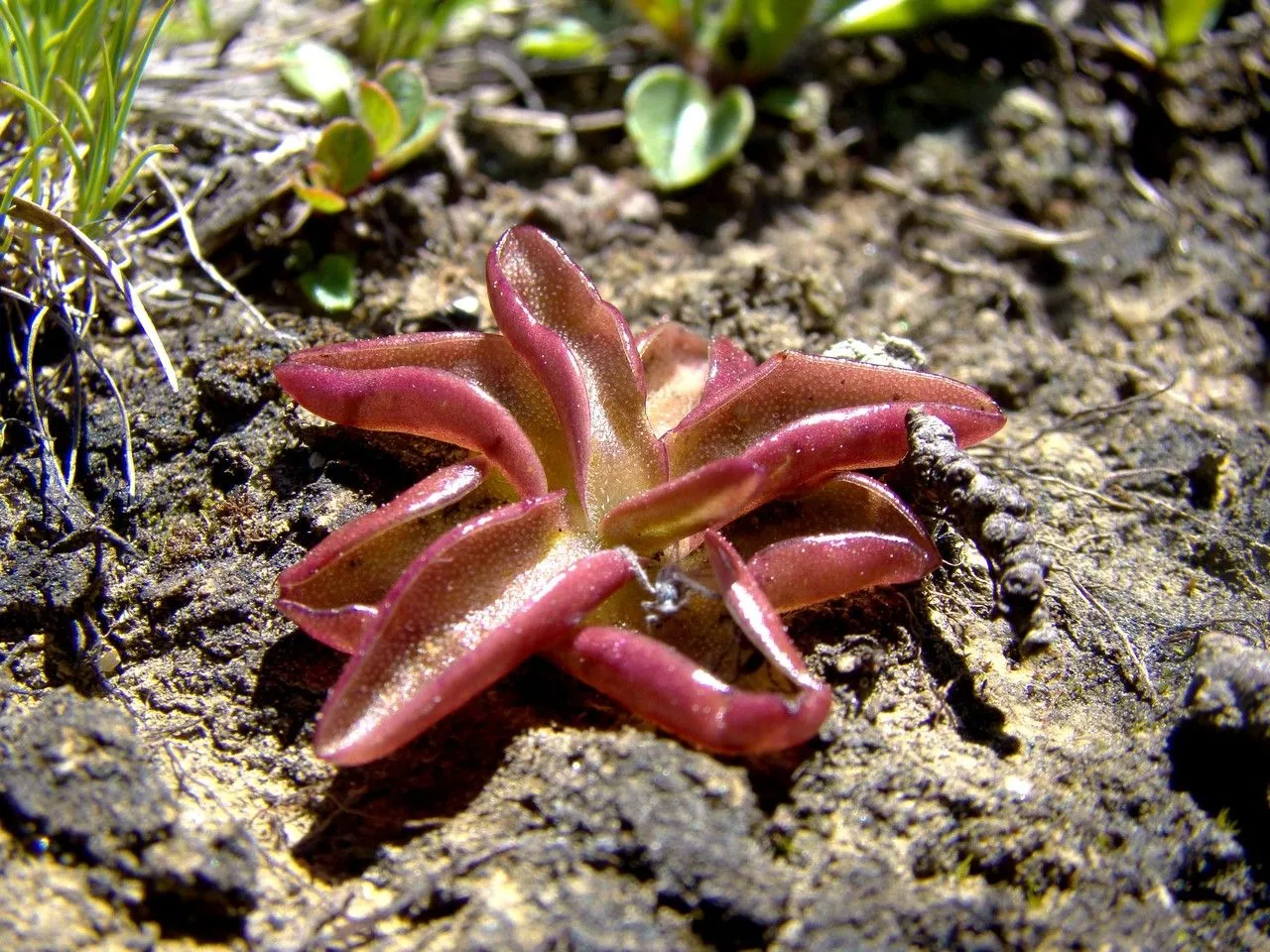
Author: L.
Bibliography: Sp. Pl.: 17 (1753)
Year: 1753
Status: accepted
Rank: species
Genus: Pinguicula
Vegetable: False
Observations: Subarctic & Subalpine Europe to Siberia, Himalaya to C. China
The Alpine butterwort, scientifically known as Pinguicula alpina, is a fascinating carnivorous plant belonging to the Lentibulariaceae family. First described in “Species Plantarum” by Carl Linnaeus in 1753, this plant has intrigued botanists and plant enthusiasts for centuries.
Pinguicula alpina thrives in harsh, cold environments, making its home in subarctic and subalpine regions across Europe, Siberia, the Himalayas, and central China. Its unique adaptation to these climates not only highlights its resilience but also its specialized mechanisms for nutrient acquisition.
Unlike many plants, the Alpine butterwort obtains essential nutrients, such as nitrogen, from capturing and digesting insects. This adaptation is particularly advantageous in the nutrient-poor soils where it often grows. The plant features sticky, glandular leaves that act as natural flypaper to trap unsuspecting insects. Once an insect is trapped, the plant secretes digestive enzymes to break down its prey and absorb the necessary nutrients.
The leaves of Pinguicula alpina are typically bright green and possess a glistening appearance due to the presence of these sticky, enzyme-laden secretions. The plant’s flowers, which bloom during the warmer months, are another remarkable feature. They typically exhibit a delicate white color with intricate veining, providing a stark yet beautiful contrast to the rugged environments they inhabit.
In addition to its horticultural interest, Pinguicula alpina holds ecological significance. It plays a role in controlling insect populations within its ecosystem and contributes to the biodiversity of the regions it inhabits.
As researchers continue to study this resilient and resourceful plant, the Alpine butterwort remains a symbol of nature’s ingenuity in adapting to some of the world’s most challenging environments.
Deu: alpen-fettkraut
Lav: alpu kreimule
Nno: fjelltettegras
Nob: fjelltettegras
Swe: fjälltätört, valkoyökönlehti
Nor: hvit tættegras, qvitt
Fin: valkoyökönlehti
Eng: alpine butterwort
Sme: vilgesdohpi, vilgesvuodjalasta
Cym: tafod-y-gors yr alpau, toddaidd alpaidd
En: Alpine Butterwort
Zh: 高山捕虫堇
Nl: Alpenvetblad
Et: Alpi võipätakas
Fi: Valkoyökönlehti
Fr: Grassette des Alpes
De: Alpen-Fettkraut, Alpen-Fettblatt
It: Erba-unta bianca
Lv: Alpu kreimule
Se: Vilgesvuodjalasta, Vilgesdohpi
No: Fjelltettegras, Hvit tættegras, Qvitt
Nb: Fjelltettegras
Nn: Fjelltettegras
Pl: Tłustosz alpejski
Sk: Tučnica alpínska
Es: Alpska mastnica
Sv: Fjälltätört, Valkoyökönlehti
Ta: பிங்குவிய்குலா அல்பினா
Uk: Товстянка альпійська
Cy: Tafod-y-gors yr Alpau, Toddaidd Alpaidd
: Alpine butterwort
Taken May 26, 2019 by Steve LE BRIQUIR (cc-by-sa)
Taken Jun 16, 2022 by manuseitz (cc-by-sa)
Taken Jun 13, 2022 by Fabien Anthelme (cc-by-sa)
Taken May 26, 2017 by Yoan MARTIN (cc-by-sa)
Taken Jul 2, 2015 by Arthur Sanguet (cc-by-sa)
Taken Jun 16, 2022 by manuseitz (cc-by-sa)
Taken Jun 16, 2022 by manuseitz (cc-by-sa)
Taken Jun 16, 2022 by manuseitz (cc-by-sa)
Taken Jun 13, 2022 by Fabien Anthelme (cc-by-sa)
Taken Jul 30, 2017 by Mathias Chouet (cc-by-sa)
Taken Jun 13, 2022 by Fabien Anthelme (cc-by-sa)
Taken Jul 7, 2015 by Tela Botanica − Marie PORTAS (cc-by-sa)
Taken Jun 11, 2021 by Lennaert Steen (cc-by-sa)
Taken Jun 11, 2021 by Lennaert Steen (cc-by-sa)
Taken Jun 21, 2018 by Daniele Boggiani (cc-by-sa)
Taken Aug 16, 2022 by Alexandre Crégu (cc-by-sa)
Taken May 26, 2017 by Yoan MARTIN (cc-by-sa)
Taken May 15, 2008 by Photoflora – Benoit BOCK (©)
Taken May 15, 2008 by Photoflora – Benoit BOCK (©)
Taken Jan 1, 1970 by Photoflora – L’Abbé COSTE (©)
Taken Jul 15, 2012 by Photoflora – Benoit BOCK (©)
Taken May 10, 2021 by Marina Melwin (cc-by-sa)
© copyright of the Board of Trustees of the Royal Botanic Gardens, Kew.
© copyright of the Board of Trustees of the Royal Botanic Gardens, Kew.
© copyright of the Board of Trustees of the Royal Botanic Gardens, Kew.
Ph maximum: 7.5
Ph minimum: 7.0
Light: 8
Atmospheric humidity: 8
Bloom months: [‘jun’, ‘jul’, ‘aug’]
Soil nutriments: 2
Family: Myrtaceae Author: (F.Muell.) K.D.Hill & L.A.S.Johnson Bibliography: Telopea 6: 402 (1995) Year: 1995 Status:…
Family: Rubiaceae Author: Pierre ex A.Froehner Bibliography: Notizbl. Bot. Gart. Berlin-Dahlem 1: 237 (1897) Year:…
Family: Sapindaceae Author: Koidz. Bibliography: J. Coll. Sci. Imp. Univ. Tokyo 32(1): 38 (1911) Year:…
Family: Asteraceae Author: A.Gray Bibliography: Pacif. Railr. Rep.: 107 (1857) Year: 1857 Status: accepted Rank:…
Family: Fabaceae Author: Medik. Bibliography: Vorles. Churpfälz. Phys.-Ökon. Ges. 2: 398 (1787) Year: 1787 Status:…
Family: Aspleniaceae Author: (Cav.) Alston Bibliography: Bull. Misc. Inform. Kew 1932: 309 (1932) Year: 1932…